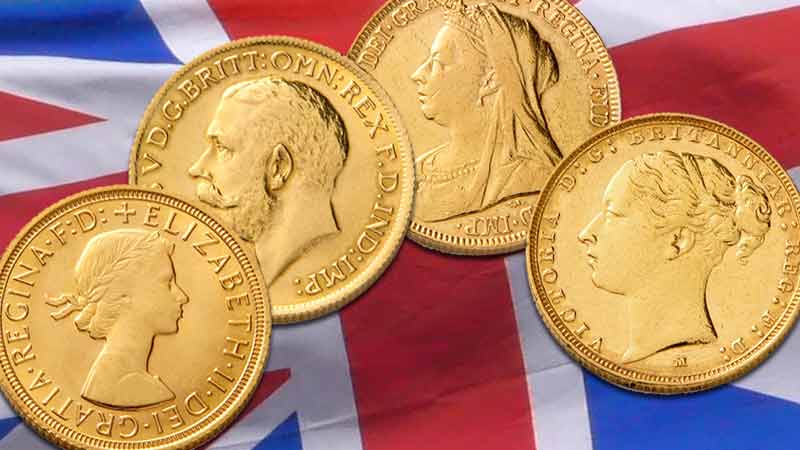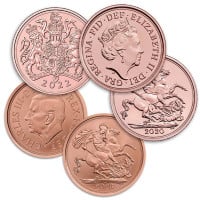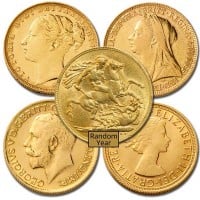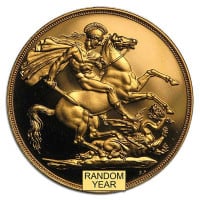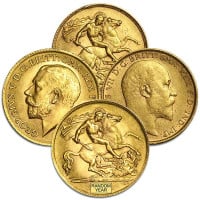British Gold Sovereign Coins
| Qty | Price Each |
|---|---|
| 1 - 19 | $622.04 |
| 20 - 39 | $615.12 |
| 40 - 99 | $608.21 |
| 100+ | Call for pricing |
| Full Tube Qty = 25 | |
|
|
|
| Qty | Price Each |
|---|---|
| 1 - 19 | $627.56 |
| 20 - 39 | $620.65 |
| 40 - 99 | $613.74 |
| 100+ | Call for pricing |
|
|
|
| Qty | Price Each |
|---|---|
| 1 - 40 | $1,205.37 |
| 41+ | Call for pricing |
| Qty | Price Each |
|---|---|
| 1 - 9 | $325.94 |
| 10+ | Call for pricing |
The Timeless Elegance of British Gold Sovereign Coins: A Historical and Technical Overview
Introduction
British Gold Sovereign coins are more than mere pieces of currency; they serve as a portal to history, embodying enduring value and standing as a testament to the rich heritage, majesty, and crown of England. Originating over two centuries ago, these coins encapsulate a unique position in the realms of numismatics and investment. As collectible items and bullion investments, Sovereigns blend historical significance with tangible value, making them an essential part of any investment portfolio.
The Birth of a Legend
The storied origin of the British Gold Sovereign traces back to 1817, marking its reintroduction by King George III to stabilize the currency in the aftermath of the Napoleonic Wars. Minted at the Royal Mint in London, these coins featured the iconic design of Saint George (St. George) slaying the dragon on the reverse, crafted by Benedetto Pistrucci. This image instantly cemented Sovereigns as symbols of British craftsmanship and resilience, highlighting the coin's value not just as currency but as a piece of art. The Sovereign's production, initiated during the reign of Henry VII, was part of a broader practice to standardize coinage across England, enhancing its circulation and role in the bullion markets.
The Victorian Era and Global Dominance
The era of Queen Victoria (1837-1901) saw the British Empire and the Gold Sovereign reach their zenith. Various depictions of Victoria, from the Young Head to the Jubilee Head and Old Head, adorned these coins, reflecting the monarch's evolving image. The Sovereign became a cornerstone of international trade, earning the title "The Chief Coin of the World" and solidifying its status as a premier gold bullion coin.
The Sovereign in Times of Turmoil
Throughout the 20th century, the British Gold Sovereign stood as a beacon of stability amidst world wars and economic fluctuations. The coin's role extended beyond domestic borders, serving as a reliable currency on the global stage, notably during World War I under the reign of George V, when Sovereigns underpinned wartime economies and solidified their reputation as a dependable global currency.
The Modern Resurgence
After pausing production in the mid-20th century, the Sovereign made a triumphant return in 1957, featuring the portrait of Queen Elizabeth II on the obverse, a practice that has continued through various monarchs, including Edward VII and Elizabeth II. Today, Sovereigns are minted in Llantrisant, Wales, offering a range of denominations from the full Sovereign to the half Sovereign, each maintaining high standards of weight, purity, and design integrity.
Collecting and Investing in British Gold Sovereigns Today
In today's market, British Gold Sovereigns are prized by collectors and investors for their gold content, historical significance, and numismatic value. The Royal Mint's commitment to quality, coupled with the Sovereign's storied history, makes these coins a desirable addition to collections and investment portfolios alike. The modern Sovereigns, along with their fractional versions, continue to be a symbol of wealth and tradition.
Technical Specifications and Designs
British gold sovereigns are gold coins that have been produced in various sizes and denominations over the years, but the term "sovereign" typically refers to a specific coin with a nominal value of one pound sterling. Since the coins do not meet the U.S. requirements, they do not currently qualify for storage in a self-directed precious metals IRA.
Here are the key details and specifications about the size, weight, and face value of the standard British gold sovereign:
- Gold Purity: 22-carat gold (91.67% pure)
- Weight: The full Sovereign weighs 7.98805 grams (about 0.2568 Troy ounces)
- Gold Content: The actual weight of gold in the coin is 7.322381 grams or 0.2354 troy ounces.
- Diameter: 22.05 mm
- Thickness: 1.52 mm
- Denomination: £1 (Full Sovereign), £0.5 (Half Sovereign), and £0.25 (Quarter Sovereign)
In addition to the full sovereign, there are also fractional sovereigns which are smaller denominations of the coin, including:
- Half Sovereign (£0.5): Half the weight of a full sovereign, with a gold content of 0.1177 troy ounces.
- Quarter Sovereign (£0.25): Introduced more recently, with a quarter of the weight of a full sovereign.
- Double Sovereign (or Two-Pound Coin; £2): Twice the weight of a full sovereign, with a gold content of 0.4708 troy ounces.
- Five-Pound Coin (£5): Five times the weight of a full sovereign, although these are less commonly found in circulation and often produced as commemorative issues.
These coins are prized by collectors and investors alike for their gold content as well as their historical and numismatic value.
The edges of British Gold Sovereign coins are typically milled or reeded. This means that the edges have small, raised lines all the way around, which were originally designed to prevent counterfeiting and the clipping of gold from the edges of the coin. Milling or reeding on the edge of a coin makes it more difficult for individuals to shave off small amounts of gold without the alteration being noticeable. This feature not only adds to the security of the coin but also provides a tactile distinction from coins of other metals or denominations.
For certain special issues or commemorative editions of Gold Sovereigns, the Royal Mint may use a decorative engraving edge design or a plain edge design. However, the standard circulation and bullion sovereigns that are produced on a regular basis typically feature this milled or reeded edge as a measure of authenticity and protection against tampering. The precision in the minting process ensures that each Sovereign's edge is uniformly detailed, contributing to its recognition as a high-quality gold coin by collectors and investors worldwide.
Designs
-
Obverse Design: The obverse of modern British Gold Sovereigns features a portrait of the reigning British monarch. Over the years, this design has been updated to reflect the current monarch's likeness such as Queen Elizabeth II or King Charles III.
-
Reverse Design: The reverse of the Sovereign consistently showcases Benedetto Pistrucci's iconic portrayal of St George slaying the dragon. This design has remained virtually unchanged since its introduction in 1817, making it one of the most recognizable coin designs globally.
Coloration Differences
The color variations among British gold sovereigns are primarily due to the alloy composition and the proportion of metals mixed with pure gold. British gold sovereigns, crafted from 22-carat gold, comprise 91.67% gold and 8.33% alloy metals, traditionally copper, which imparts a reddish hue to the coins. This hue is a direct result of the copper content used to enhance the coin's durability for circulation.
Occasionally, the inclusion of small amounts of silver or other metals in the alloy can alter the coin's color, making it appear lighter or affecting its hue in other ways. Over different historical periods, the specific mix of alloy metals might have varied slightly, influenced by changes in minting techniques, the availability of metals, or other factors, leading to subtle differences in color among coins minted at different times.
Additionally, factors such as wear, aging, and environmental exposure can change a coin's surface color and texture over time, further contributing to the diversity of appearances within sovereigns.
Moreover, these coins have been minted in various locations worldwide such as mints in Australia (1855-1931), India (1918), Canada (1908-1919), and South Africa (1923-1932)- including but not limited to the cities of London, Sydney, Melbourne, Perth, Ottawa, Bombay, and Pretoria. Variations in minting practices could introduce further discrepancies in color.
Collectors often value these color differences as they add to the coins' historical and numismatic appeal, showcasing the rich legacy of British gold sovereigns through their varied hues and shades.
Although older British Gold Sovereigns have more yellow color to them than the more pink or red modern British Gold Sovereigns, they are of the same gold content, purity, and weight.
Conclusion
British Gold Sovereign coins transcend mere currency; they embody centuries of history, cultural significance, and enduring value at a great price. From their origins in the 19th century to their continued relevance in the digital age, these coins remain symbols of stability, wealth, and historical importance. Whether you are a collector, investor, or history enthusiast, British Gold Sovereigns offer a unique opportunity to own a piece of English numismatic and cultural heritage - making them a valuable addition to any investment portfolio or precious metal collection.
Buy British Gold Sovereign Coins Today
If you have any questions (FAQ) or are ready to place your order for these British Gold Sovereign Coins, other prestigious gold bullion coins from around the globe, silver coinage, or any aspect of gold investing, please don't hesitate to reach out to our dedicated, zero-commission, customer service team at our phone number:
- 1-800-800-1865
Money Metals Exchange, established as a trusted name in 2010, boasts an A+ rating from the Better Business Bureau (BBB) and has garnered thousands of 5-star reviews from our satisfied customers throughout the United States (U.S.) and many other regions worldwide. We take pride in being recognized as the Best Overall Precious Metals Dealer by Investopedia.
Keep up to date by subscribing to the Money Metals Newsletter, offering updates on precious metals news, detailed content information, product specifics, insightful market analyses, geopolitical commentary, economic outlooks, spot prices, and access to our engaging weekly podcasts.
Connect with us on various social media platforms, including Facebook, Instagram, YouTube, X (Twitter), TikTok, and LinkedIn, for the latest updates and developments in the gold investing arena.
Choosing to invest in British Gold Sovereign Coins today is a smart move, whether you are an experienced numismatist or a newcomer to the investment scene, looking to diversify your portfolio with high-value precious metal coins. Consider also exploring other gold coin options, British Gold Sovereign silver editions, the full range of silver coins, the Tudor Beasts collection, gold rounds, gold bars, and investment-grade jewelry to complement your investment portfolio.




